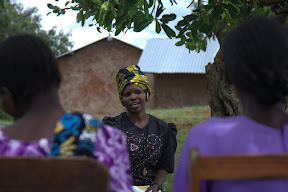- the map has been updated, check it out on the right hand side
- Andrew and I walked 15 mi (24 km) to map out the boundary of the area we work in
- many new markers have been added with pictures, click on the markers to see them
(Note: Sorry for the delay, I've been overloaded with work as I try to finish up some of our projects before we head out of Kenya for a month, more on that in my next post. I did get the content of what I was going to post up on time, just not my post. Check out the map on the side.)
Last week I spent most of my time roaming around the area with GPS and camera in hand to map and photograph as much of the area as possible. The original map I made didn't have much in the way of location information and no pictures to associate with any of the structures. This time, I've filled out the map with just about every interesting place there is to see along with pictures of most of them.
On Tuesday of last week, Andrew, the agriculture field manager (like Lucas for w+s) walked all over creation with me to map out the boundary of the Nyametaburo and Nyangiti sub-locations that we work in. Andrew and Jake had walked the boundary before but the data was lost to a virus.
It was a pretty amazing walk, taking about 5 hours and covering 15 mi or a little more than 24 km. We walked through swamps and marshlands, crossed rivers countless times, went up and down huge grades, and pretty much wore each other out. The views were amazing the entire time as the boundary is out in the middle of nowhere for most of the time. A good portion of the boundary follows rivers so we got to see some of the beautiful valleys in the area. Unfortunately, because we have just finished the rainy season, all of the rivers are swollen to the brim making every time we crossed the river quite an adventure.
The perimeter walk was probably the most involved and biggest day of my mapping efforts simply due to the sheer effort required to walk every foot of the perimeter. I can't thank Andrew enough for being willing to take the time to spend a day hiking with me. I definitely got him a few cold ones and dinner in return for his selflessness.
The rest of the week I spent walking and driving the motorcycle (piki piki as you learned in a previous post) with the GPS in my backpack and camera on my hip. I added quite a few features to the map including schools, churches, meeting places, and some points of interest (like Taragwiti hills and a picture of a typical path I drive on).
I've also included some important infrastructure such as the many bridges we use to get to and from Nyametaburo, our central hub for most of our work. The bridges are really important to Nuru and we are considering some projects to improve a few because they are so vital to the people we work with. One of the main bridges, on Nyametaburo road, floods when it rains hard. It makes the river impassable and can make people have to wait hours at a time. If we were able to work with the local government and possibly another non-governmental organization (NGO) like Nuru, we may be able to raise the surface of the bridge by adding a structure on top of the existing bridge and provide more drainage to prevent flooding.
Please check out the map on the right hand side and the pictures associated with it. I haven't posted any pictures to my album because all of them that I have taken this week have gone to the map. To see them, just click the place markers and the pictures will pop up.
Enjoy the map and leave any comments, suggestions, or questions you may have about the map. We're trying to improve it every day to not only use it as a tool for our work but also to give people like you the chance to follow what we do.
Funny side note, Sammy, Sally's (the salamander that's not a salamander, see pictures in previous post) younger brother, was hanging out in Aerie's pants the other day. Aerie was walking around complaining about some insect being in his pants, up on his thigh, biting him. At first he wasn't sure what it was or if there was actually anything in his pants. Eventually, he realized he wasn't crazy and shook the leg of his pants and Sammy popped out on Aerie's shoe.
























































